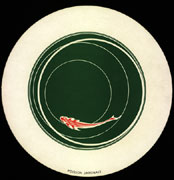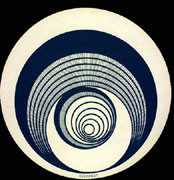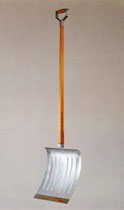Intentions: Logical and Subversive by Richard K. Merritt |
||||||||||||||||||||||||||||||||
|
Abstract This paper examines the intersection of symbolic logic, immersive experience [VR] and concept visualization in the interpretation of the oeuvre of Marcel Duchamp. Influenced by the mathematicians Henri Poincaré and Élie Jouffret as well as his own intense practice of chess and logic, Duchamp sought to merge the poetic and visceral nature of the aesthetic experience with the logical and systematic character of science. This convolution of elements as disparate as chance, 3d and 4d space-time, linguistics, logic and authorship does not allow for comfortable definitive explanation but rather one, like his work itself, that engages simultaneous multi-dimensional thinking. Duchamp questioned
the purpose of 'retinal art', art which is merely visually beautiful,
and examined the limitations of science as a singular method of interpreting
and communicating experience. The body of his work stands as a systematic
yet playful critique of deterministic reasoning. Using symbolic logic
to characterize the most common interpretations of Duchamp's work,
the author suggests that Concept Visualization in 3d immersive experience
offers a unique method for exploring and introducing the complex lattices
of interpretation, intention and concept in the work of Marcel Duchamp. Introduction
The history of art is filled with artists whose discoveries and research were labeled or advocated as objet d' art and whose scientific utility was not discovered until many years often centuries later. However, it is the supposition of this author, that no other artist cloaked his or her intentions in deception as a tactic to subvert conventional interpretation. Noted and controversial Duchamp scholar Rhonda Shearer has garnered attention by a stunning hypothesis about the many realms of Duchamp's work. In 1919 Duchamp drew a supposed impromptu mustache on a reproduction of Leonardo da Vinci's Mona Lisa (Fig. 2) and titled it L.H.O.O.Q. (Fig. 3) When these letters are read aloud they say "Elle a chaud au cul" or "She has a hot ass" in French. Having created this work of art Duchamp stated that it revealed a truth about his noted foregoer. Duchamp championed the "ready-made", a manufactured object transformed into art merely by its selection and placement in an aesthetic gallery or museum context. In so doing, Duchamp altered the significance of the objet d' art as a precious commodity created by the artist. Duchamp often maintained complex documentation of the purchase or discovery of his "found-objects". In the case of L.H.O.O.Q., Duchamp asserts that it was purchased in a postcard shop on Paris' rue de Rivoli. This notion that the art object is defined and given value by its context not by an empirical judgement of aesthetic value would transform the art of the twentieth century, greatly influencing Conceptual Art and Postmodern movements. Duchamp's assertion that art is a matter of selection and context was perhaps a precursor to Baudrillard's Second Order of Simulacra. According to Shearer, Duchamp had another more subversive objective. She asserts that Duchamp's L.H.O.O.Q. was in fact a creation of Duchamp--a composite photograph of himself taken in 1912 and a reproduction of Leonardo Da Vinci's Mona Lisa. Shearer's research suggests that not only was L.H.O.O.Q. created by Duchamp or fabricated to his specifications but so was the snow shovel in In Advance of the Broken Arm (Fig. 4), the bird cage in Why Not Sneeze Rose Sélavy (Fig. 5), the ampoule in Ampoule Contenant 50cc d'air Paris (Ampoule containing 50cc of Paris air) (Fig. 6), and the urinal in Fountain (Fig. 7) signed R. Mutt (the famous object refused exhibition in the Society of Independent Artists show in 1917). This controversial theory is gaining greater attention in recent years, although not without significant turmoil. The notion of the "ready-made", would remain safe according to Arthur Danto, art critic for the Nation, and Thierry di Duve, author of Kant After Duchamp, as this concept of "art object in context" has been an accepted convention of art making and interpretation for three quarters of a century. However if Shearer proves to be correct in her assertions both Danto and the Immanent Duchamp scholar and author Francis Nauman (Marcel Duchamp: The Art of Making Art in the Age of Mechanical Reproduction) would find this a "grand act of deception."
Duchamp's work, particularly that which displays his keen interest in science and mathematics is also garnering attention outside of the disciplines of art history and art criticism. New York University Physicist Jonathan Williams postulates that Duchamp's deep play with physics or what Duchamp and the playwright Alfred Jarry referred to as "pataphysics", was a systematic way of satirizing early 20th century deterministic systems of scientific thinking. Duchamp, according to Williams, began this direction through his investigations of non-Euclidean geometry, fourth dimensional space-time, electromagnetism, and radiation. Duchamp's playful explorations of these areas seems to be a harbinger, of sorts, for some of the foundations of quantum mechanical theory such as Heisenberg uncertainty principle and the Erwin Schrodinger equations. Duchamp's systematic critiques were not limited to the scientific thinking of the day but also confronted modes of artistic production. Duchamp's disinterest in what he referred to as "retinal art" or art which solely engaged the reproduction of visual experience was methodically deconstructed and supplanted by an art which focused on the grey matter or existed in the realm of pure intellect. "All through the nineteenth century the phrase 'bête comme un peintre' or 'as stupid as a painter'", Duchamp said. "And it was true- that kind of painter who just puts down what he sees is stupid." For Duchamp, traditional art making merely copied itself in kind of mobius strip of mimesis and self-reflection simply cloning itself over and over again. As the myth goes,
Duchamp gave up art in favor of playing chess throughout the world.
"All chess players are artists but not all artists are chess
players." Duchamp used chess as a kind of model for much of his
work, using it in his explorations of physics, mathematics and logic.
This does not mean that he solely engaged in a form of sublime mathematically
derived art. He continued his love of semantics, word games and humor
throughout his life one sees this in L.H.O.O.Q. as well as
his frequent use of the alter ego Rrose Sélavy (Eros is Life). Any
complete and singular interpretation of Marcel Duchamp's work is quite
impossible as it is a lattice manifesting complex interweaving of
intentions; mathematics, science, logic, art, consumer critique word
play and alter ego. Parsing the Oeuvre The human propensity for binary oppositional thinking has been studied by psychologists and linguist and is evident in a great portion of western philosophy from Diogenes Laertus 200AD (lives and Opinions of Eminent Philosophers) to the present. Nowhere is this more apparent than in the discipline of art history, particularly as practiced in the first half of the twentieth century. Often art history has been essentially a historiography of connoisseurship, determining why one body of work by one artist is necessarily better than another body of work by another artist. This reasoning was held together by the supposition of progress, in the inevitable evolution of one mode of artistic production to another. Though not the subject of this study it is notable that when one examines art historiography (or any historiography for that matter) events, intentions and outcomes are often limited to singular reasoning. The academy, when confronted by opposing singular reasoning on ! any particular individual or subject matter, results in imbroglio. Critical interpretation of Duchamp's body of work and his intentions is vested in this sort of competition between singular theories. Duchamp consistently
plays with these battles often examining them through his own prism.
As Duchamp advocates the value of the "ready-made" he simultaneously
describes his intent to define existence "through slightly distending
the laws of physics and chemistry." By using his own form of
"absurd mathematics" he simultaneously critiques scientific
thinking, logic, the definition of art, the artistic mode of production
and aesthetic interpretation. Duchamp writes:
This formula
demonstrates the limits of scientific reasoning by illustrating its
inability to explicate immeasurable, highly personalized, data. By
inserting variable equivalencies for intention, dread (crainte) and
desir (desire) Duchamp demonstrates the limits of deterministic mathematics
and hints at his attempts to demonstrate the breakdown of rational
models of examining reality. Jonathan Williams in his article
Pata or Quantum the End of Deterministic Physics, likens
this propensity in Duchamp's work to the Schrodinger equations which
demonstrated that the behaviors, qualities and position of quantum
particles needed to be expressed in terms of statistical probabilities
thus rendering vacant the possibility of determining that a subatomic
particle had any fixed quality at any given point in time. Duchamp's
continued fascination with illustrating this notion also points out
his interest in expressing the difficulty that systems of logic have
in making distinct calculations of human emotional variables. As one
can see when examining the diversity of Duchamp's work and intentions,
traditional art historical and art critical interpreters were and
in many cases remain befuddled. >>Next page
1 2 Figs.
1, 3~7
|
||||||||||||||||||||||||||||||||




















